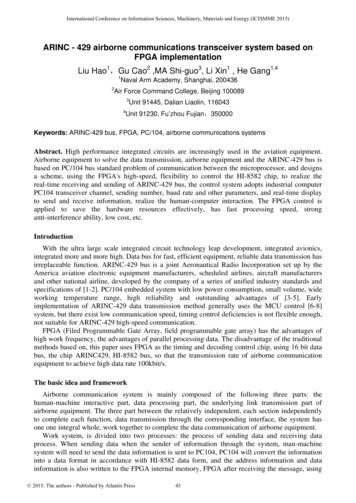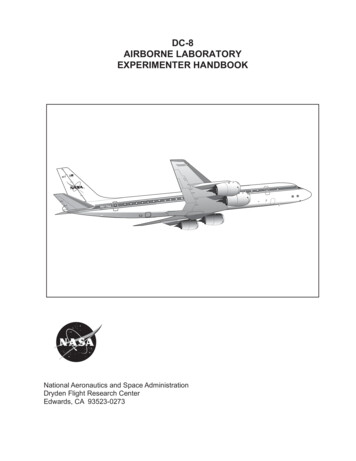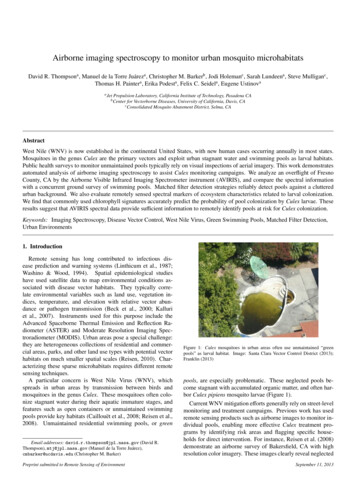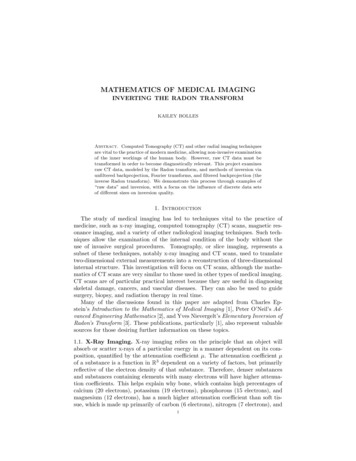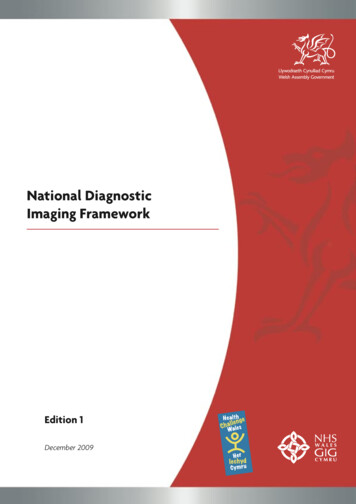
Transcription
CALIBRATING DIGITAL PHOTOGRAMMETRIC AIRBORNE IMAGING SYSTEMS INA TEST FIELDEija Honkavaara, Lauri Markelin, Eero Ahokas, Risto Kuittinen, Jouni PeltoniemiFinnish Geodetic Institute, Geodeetinrinne 2, P.O. Box 15, FI-02431 Masala, Finland – first.lastname@fgi.fiKEY WORDS: Accuracy analysis, Digital photogrammetry, Geometry, Radiometry, Resolution, Sensor calibrationABSTRACT:Passive and active digital imaging is rapidly replacing film imaging in photogrammetric data capture. The reliability, accuracy, andefficiency of airborne photogrammetry are based on calibrated, high-quality sensors and rigorous processing. The calibrationprocesses of the digital photogrammetric airborne imaging systems are under development. Central challenges in the development ofthe calibration are the extensive variation in digital systems, the need for radiometric calibration, and the necessity for accuratesystem calibration. Test field calibration is a potential approach for determining the system calibration. An investigation was carriedout on the need for and feasibility of test field calibration of the geometry, radiometry, and spatial resolution of digital photogrammetric imaging systems. A unified framework and parameterization for the calibration of these properties was devised. A prototypetest field calibration methodology was developed and the need for and feasibility of the test field calibration was investigated usingempirical image materials. In the empirical study, data sets from the three first-generation commercial digital photogrammetriclarge-format sensors, ADS40, DMC, and UltraCamD were used. The results proved the feasibility of the test field calibration; apermanent test field can be an efficient, highly automated, and reliable tool for system calibration. The test field calibration wasnecessary for the evaluated systems to provide the missing or invalid calibration parameters and to assess their measurementcapability. The results also showed that calibration of the high quality photogrammetric systems in a test field was feasible.reference targets, and it often determines the system calibrationfrom the data of a certain mapping flight.1. INTRODUCTIONThe transition from film imaging to digital imaging by activeand passive instruments causes a revolution in airborne photogrammetry. Optimal use of this new technology enables fastdata captures, high accuracy, a high level of automation, and ahuge increase in applications. The users of airborne photogrammetric cameras have traditionally been concerned on geometricissues, but the optimal utilization of the new digital sensorsnecessitates also the rigorous processing of the spatialresolution and radiometry.Calibration processes of the digital photogrammetric airborneimaging systems are under development. Central challenges inthe development of the calibration are the extensive variation indigital systems, the need for radiometric calibration, and thenecessity for accurate system calibration. The complexity of thecalibration task has been widely recognized (ASPRS, 2000;Cramer 2004; 2006; USGS, 2005; Stensaas et al., 2007). Ageneral expectation is that test field calibration would be anefficient tool for dealing with the above issues (ASPRS, 2000;Pagnutti et al., 2002; Cramer, 2004; 2006; Stensaas, 2007), butthe performance, need for, and feasibility of test fieldcalibration has not been empirically proven.To fulfil the reliability requirement set for the photogrammetryand to obtain high efficiency, calibrated, high qualityinstruments and rigorous methods are used in thephotogrammetry. Calibration is defined as a “process ofquantitatively defining the system responses to known,controlled signal inputs” (Morain and Zanoni, 2004). The fourtasks of the digital photogrammetric airborne imaging systemcalibration are: 1) sensor component calibration (e.g. the lens orCCD), 2) sensor calibration, 3) image acquisition systemcalibration, and 4) image product generation system calibration.The first two tasks can be carried out in well-controlledconditions in a laboratory. The calibration of the imageacquisition system and the image product generation system canonly be performed under airborne conditions either using testfields or on a self-calibration basis, whereby the methodscharacterize the entire measurement system under operationalconditions (in situ). Test field and self-calibration conceptsoriginate from geometric calibration, but they can begeneralized to cover spatial resolution and radiometry asfollows. The test field calibration determines the systemcalibration using images collected over a photogrammetric testfield, which is an area with characterized reference targets andmeasurement devices suitable for calibrating photogrammetricimaging systems. Self-calibration does not require characterizedAn investigation was carried out to evaluate the need for andfeasibility of test field calibration of geometry, radiometry, andspatial resolution of digital photogrammetric imaging systems.A unified framework and parameterization for the calibration ofthese properties was devised. A prototype methodology for testfield calibration of digital photogrammetric airborne imagingsystems was developed. The need for system calibration wasinvestigated by using empirical image materials in order toevaluate the sufficiency and validity of system calibrationprovided by sensor manufacturers. The feasibility of systemcalibration in test field was empirically investigated byevaluating the feasibility of constructing test fields andcalibrating the systems at test fields. The investigation providedinformation on the performance of digital photogrammetricsensors and test field calibration, and gave recommendations forthe calibration process of digital photogrammetric systems andthe construction of photogrammetric test fields. This articlesummarizes the key results of these investigations. The detailedresults are given by Honkavaara et al. (2006a; 2006b; 2006c;2008), Honkavaara (2008) and Markelin et al. (2008).555
The International Archives of the Photogrammetry, Remote Sensing and Spatial Information Sciences. Vol. XXXVII. Part B1. Beijing 526-27.9.20051.7., 5.7. 2006GSD [cm]44, 8, 25, 5045, 815, 254, 8PropertyGGGG, SR, RRRTable 1. Empirical image materials. Analysed properties: G:geometry, SR: spatial resolution, R: radiometry.Figure 1. The Sjökulla image quality test field: 1) permanentdense resolution bar target, 2) permanent gray scale, 3)permanent reflectance targets, 4) sparse resolution bar target, 5)permanent circular targets, 6) portable Siemens star, and 7)portable gray scale.2. MATERIALS AND METHODSThe research approach was to collect image materials in aphotogrammetric test field and by analysing the imagery todraw conclusions about the test field calibration.2.1 MaterialsReference data collectionImage data collectionThe empirical image materials were collected by the firstgeneration digital large-format photogrammetric sensors in2004-2006 (Table 1). The empirical study concerned calibrationof the geometry of the DMC and UltraCamD, the spatialresolution of the DMC, and the radiometry of the DMC,UltraCamD, and ADS40. The complete system calibration wasperformed only for the DMC.Mission planningTest fieldpreparationImage collection atSjökullaIn situ GPSmeasurementDigital image“development”GPS or GPS/IMUprocessingIn situ reflectance,weather, radiationmeasurementAerial triangulationImagesExterior orientationsImage coordinatesGPS or GPS/IMU data2.2 MethodsGeometriccalibrationThe permanent Sjökulla test field together with somesupplementary portable targets is a prototype photogrammetrictest field (Honkavaara et al., 2008). The Sjökulla test field wasestablished in 1994. It consists of an image quality test field forradiometric and spatial resolution calibration (Figure 1) and networks of targeted benchmarks for geometric calibration at large,medium, and small imaging scales. Permanent spatial resolutionand reflectance targets made of gravel are special features of theSjökulla test field (Peltoniemi et al., 2007; Honkavaara et ionAnalysisCalibrationcertificateFigure 2. Test field calibration process flow (Honkavaara,2008).was obtained from the dense resolution bar target (Figure 1)using an automatic method (Ahokas et al., 2000; Honkavaara etal., 2006c). The MTF was obtained from the Siemens star(Figure 1; Honkavaara et al., 2006c) using a method based onthe method developed by Reulke et al. (2006) and Becker et al.(2006). 10% MTF and σPSF were derived from the MTF.The central calibration quantities are the models and parametersthat are needed to the transform the system inputs to the outputsand the quality indicators for these transformations. Acomprehensive parameterization developed in this study ispresented in Section 3.4.A portable 8-step gray scale was used as the reflectancereference target for the reflectance based vicarious radiometriccalibration (Figure 1; Honkavaara et al., 2008; Markelin et al.,2008). The limitations of the missions were that theatmospheric and illumination data were not collected during thetest flights and that the reference targets had not been calibratedcomprehensively. The laboratory-determined target spectralreflectance and the MODTRAN 4 default atmospheric modelswere used (Markelin et al., 2008). Due to these limitations, thecalibration could only be performed partially. The results of thelinearity and dynamic range evaluations can be consideredreliable, while the sensitivity and absolute calibration resultsshould be considered indicative.The calibration process flow is shown in Figure 2; the subprocesses are the image data collection, reference data collection, and analysis (Honkavaara et al., 2008; Honkavaara, 2008).Geometric calibration is based on self-calibrating bundle blockadjustment; central parameters are the interior orientations andthe system distortions (Honkavaara et al., 2006a; 2006b;Honkavaara, 2008). To support the geometric calibration, amethodology utilizing simulation and empirical results wasdeveloped for the sensor evaluation and photogrammetricproduct quality prediction (Honkavaara et al., 2006b). Thelimitation of the flight missions was that accurate exteriororientation information was not collected. The data were notsuitable for interior orientation determination because theSjökulla test field is flat and the blocks were optimized for thecalibration with GPS/IMU support.3. RESULTS AND DISCUSSION3.1 Geometric calibrationThe geometry of three technically similar UltraCamDs and oneDMC was calibrated (Table 1). In one of the UltraCamDThe spatial resolution was assessed by evaluating the resolvingpower (RP) and modulation transfer function (MTF). The RP556
The International Archives of the Photogrammetry, Remote Sensing and Spatial Information Sciences. Vol. XXXVII. Part B1. Beijing 2008pensated for the distortions and improved the point determination accuracy. With self-calibration, the systems providedusually a high geometric accuracy, but without self-calibrationin many cases the systematic block deformations were considered to be intolerable in many photogrammetric applicationsmissions, blocks were collected with 4 cm, 8 cm, 25 cm, and 50cm GSD, and three repetitive blocks with 8 cm GSD werecollected during two days; for the other two UltraCamDs, onlysingle blocks with 4 cm GSD were available. The DMC wascalibrated using blocks with 5 cm and 8 cm GSD; repetitiveblocks with 8 cm GSD were collected on two consecutive days.The following results are based on Honkavaara et al. (2006a;2006b) and Honkavaara (2008).These results are consistent with other recently published resutsof the first generation systems (e.g. Alamús et al., 2006; Baz etal. 2007; Cramer, 2007b). A significant consequence of theempirical investigations has been that camera manufacturershave started to take action to eliminate distortions (Dörstel,2007; Gruber, 2007). Improved systems and processing chainsare now available but their performance has not been proved byindependent empirical tests yet.A fundamental empirical result was the detection of the distortions in the multi-head images, which caused block deformations;this was verified with all UltraCamD and DMC blocks. Thesensor manufacturers did not provide information on these distortions, nor did they provide tools for compensating for them.Examples of the block height deformations for the DMC andUltraCamD are given in Figure 3 (blocks with four image strips,60% forward and side overlaps, and 12 GCPs). Block heightdeformations in the central area of the block were estimated bycalculating averages and standard deviations in the deformedarea (marked by a circle). They were -10.3 cm and 2.2 cm forthe UltraCamD, and -4.5 cm and 1.6 cm for the DMC whenself-calibration was not performed. With self-calibration(single-head physical model) the corresponding values were 5.2 cm and 1.3 cm for the UltraCamD and 2.0 cm and 1.2 cmfor the DMC, respectively. The systematic height deformationsin the central areas of the example blocks were for theUltraCamD 2.5 times and for the DMC less than 1 time thetheoretical height determination accuracy when self-calibrationwas performed. Without self-calibration, the values were 4.5and 1.5, respectively.3.2 Spatial resolution calibrationIn the empirical spatial resolution calibration study, DMCimages with 5 cm GSD and 8 cm GSD were used; two blockswith an 8 cm GSD were collected over consecutive days (Table1). The effect of the distance from the image center, the altitude(500 m and 800 m), and the flying direction were evaluated.The following results are based on Honkavaara et al. (2006c)and Honkavaara (2008).The resolution of the DMC panchromatic images weakened asthe distance from the image center increased; the resolutionreduction factor from the image center to the image corner wasup to 2 (Figure 4). One important reason for this behavior is theoblique construction of the system. Theoretical evaluationshowed that the resolution reduction factors from the nominal12 μm pixel size, caused by the image tilt, were at theirmaximum 1.6 in the cross-flight direction and 1.4 in the flightdirection in the corners of the image.Different UltraCamDs had different distortion patterns. One ofthe tested UltraCamDs did not function correctly, whichappeared in the form of exceptionally bad point determinationaccuracy, poor σˆ 0 , and large systematic distortions. With bothDMC and UltraCamD, the repeated blocks showed somesimilarities (e.g. similar distortion patterns in many cases). Thisindicated some level of stability, also with respect to altitude,but some unexplained instability appeared as well.The effect of position on spatial resolution was modeled using alinear model as the function of the radial distance from theimage center (Figure 4). The intercept indicates the resolution atthe image center, and the slope indicates the resolution decreasewith the increasing distance from the image center. Evaluationa)The single and multi-head additional parameters partially coma)RP (lines/mm)100806040200f: y -0.4165x 77.11R2 0.7981cf: y -0.2142x 75.981R2 0.34240204060Distance (mm)5 cm5 cmfcfTheor fTheor cfLinear (cf)Linear (f)d1 g580100b)b)d1 g51.4sPSF (pixel)1.25 cm5 cm1.00.80.60.4f: y 0.0073x 0.6927R2 0.65750.2cf: y 0.0034x 0.8012R2 0.31150.00.020.040.0fcfLinear (f)Linear (cf)60.080.0Distance (mm)Figure 3. Errors at independent checkpoints in heightcoordinates: a) UltraCamD, GSD 4 cm. b) DMC, GSD 5 cm.Left: no self-calibration, right self-calibration using single-headphysical parameters.Figure 4. Analysis of a) RP and b) σPSF as a function of thedistance from the image center. (f: flight and cf: cross-flightdirection557
The International Archives of the Photogrammetry, Remote Sensing and Spatial Information Sciences. Vol. XXXVII. Part B1. Beijing 2008was made in flight and cross-flight directions. The statisticsindicated a significant linear fit for the RP, 10% MTF, and σPSFat a 5% confidence level, excluding the σPSF in the cross-flightdirection with the imagery with a 5 cm GSD. These regressionmodels can be regarded as spatial resolution models of theDMC panchromatic images.a)4000PANRAW DN3500R3000G2500B2000NIR15001000The empirical spatial resolution analysis showed that theresolution of the panchromatic DMC images was lower than theNyquist limit, and dependent on the position in image, flyingaltitude, and direction of flight. The sensor manufacturer didnot provide information about these factors. It is likely thatselecting the flight parameters of the DMC using the nominalinformation about the sampling interval will not lead intoacceptable results in many photogrammetric applications.500000.050.1At-sensor radiance0.150.2b)20PAN15RGRadiance error (%)103.3 Radiometric calibrationThe ADS40, UltraCamD, and DMC were radiometrically testfield calibrated. For each sensor two different flying heightswere used. The following results are based on Honkavaara(2008) and Markelin et al. (2008).B5NIR0-50102030405060-10-15-20-25-30Nom inal reflectance (%)Figure 5. DMC radiometry evaluation, GSD 5 cm. a) DNs plotted as a function of at-sensor radiance. b) Absolute calibrationresiduals as a % of radiance, 5% and 70% targets were used as areference (5% and 50% for green channel).The systems were linear in response. As an example, a radiometric response plot of one DMC image is shown in Figure 5a.In some cases, however, nonlinearity appeared. Some of thechannels of the DMC and UltraCamD were saturated in someimages at bright reflectance values, which appeared as nonlinearity (for instance, the green channel of the DMC in Figure5a). Nonlinearity appeared also with the 20% reflectance targetbecause of the inaccuracy of the reference value (see below).et al., 1994), approximately 6% absolute radiometric accuracycan be expected. This accuracy is similar to values obtained forthe remote sensing systems, and it could be further improved byimproving the reference target uniformity and calibration.The A/D-conversion is made with 12 bits for the DMC and with14 bits for the UltraCamD and ADS40. The DMC used the 12bit dynamic range entirely, while UltraCamD and ADS40panchromatic channel indicated a close to 13-bit dynamic range.The dynamic range of the ADS40 multispectral channels was aslow as 9-10 bits. Differences in the sensitivity of variouschannels were the smallest for the DMC and the largest for theADS40. The solar elevation angle was approximately 28 forthe ADS40, 35 for the DMC, and 50 for the UltraCamD.The absolute radiometric calibration was determined for theDMC and ADS40. Either the linear model with gain and offsetparameters or with the gain parameter on its own wasappropriate for absolute calibration. The precision of the gainparameters was 1-2% for the DMC (4-8 targets) and 3-5% forthe ADS40 (5 targets). The relative empirical accuracy ofabsolute calibration was evaluated by determining thecalibration using subsets of the reference targets and evaluatingthe accuracy with the remaining targets. This accuracyevaluation is considered to be relative, because the accuracy ofthe atmospheric correction was not known. The errors in thecheck reflectance targets are given for one DMC image with 5cm GSD in Figure 5b; the darkest and brightest targets wereused for the calibration. The errors were clearly greater for the20% target than for other targets, which indicated outlier. Theerrors in the green channel were clearly larger than the errors inother channels; this was caused by the saturation of the greenchannel at greater than 45% reflectance. The saturation is anoutlier, which caused bias to the calibration parameters anddeterioration of accuracy. The errors were less than 6%,excluding the green channel and the 20% target. The RMSEswere 3.3-4.5%. The major source of error was the calibrationinaccuracy and non-uniformity of the reference targets.Assuming an atmospheric modelling error of 3-4% (e.g. BiggarSensitivity of the color channels appeared to be a serious limitation for the first generation ADS40 in limited illumination conditions with a high-speed aircraft. The large sensitivitydifferences in the ADS40 are partially caused by the widths ofthe bands and the filtering principle. Collection of images witha smaller than 15 cm GSD was not even possible by the systemtested. These properties can limit the usability of the 1st generation ADS40 in high latitudes, with a high-speed aircraft;Frickler (2007) states that the 2nd generation ADS40 has animproved sensitivity, but independent empirical results are notyet available. The flying speed and illumination conditions didnot cause problems for the DMC and UltraCamD because theexposure time could be increased with the help of forwardmotion compensation. However, it appeared that for theUltraCamD and DMC, the exposure and aperture settings werecritical parameters causing a risk of over-exposure. Missingcalibration parameters, radiometric processing chains, andinformation on radiometric performance are serious shortcomings hindering the quantitative use of the radiometry of thesensors.3.4 Parametrization of the test field calibrationA general parameterization for geometric, spatial resolution andradiometric calibration was devised based on the results (Honkavaara, 2008): a) system calibration model and its parameters;b) accuracy of the calibration model (precisions of parameters,residuals); c) empirical accuracy of output products; d) otherperformance indicators; e) performance prediction method andits accuracy. The exact parameters are sensor dependent. Aninteresting quantity here is the performance prediction method.The capability to predict system performance is often advan-558
The International Archives of the Photogrammetry, Remote Sensing and Spatial Information Sciences. Vol. XXXVII. Part B1. Beijing 2008The results showed that the test field calibration of the systemswas feasible (Honkavaara, 2008):–The test field calibration of the geometry was a powerfultool for detecting the precision and bias of the sensormodel and output products. The calibration blocks did notenable the determination of the geometric system calibration model. However, current literature and experienceswith analog frame cameras indicate that an appropriatesensor model could be determined in a test field.–Spatial resolution of the DMC panchromatic images couldbe calibrated in the test field The comprehensivecalibration blocks enabled the development of empiricalmodels for spatial resolution which outperformed othertested resolution prediction methods.–The radiometric study showed that the radiometricresponse of the ADS40, DMC, and UltraCamD was linear.Calibrating this model in the test field is feasible. Theexpected calibration accuracy corresponds to results fromremote sensing systems. The radiometric data provided bythe sensors are easily applicable to quantitative use, thusradiometric calibration is advantageous.The extent to which the parameters determined in the test fieldcan be utilized in subsequent mapping processes is dependenton the development of models that are accurate and on thestability of the systems.tageous; the predictability could be considered as onerequirement for the photogrammetric systems.3.5 Recommendations for calibration process of digitalphotogrammetric airborne imaging systemsThe analysis showed that the comprehensive calibration processshould consist of laboratory, test field, and self-calibration, andof product level validations (Honkavaara, 2008). Laboratorycalibration was needed, because it is the most accurate method.It enables system evaluation in controlled conditions with allpossible settings, and all parameters cannot be determined bytest-field calibration. Calibration in a test field is a sophisticatedmethod of assessing the system calibration in controlledconditions, assessing the measurement capability of the system,and determining optimum mission parameters for variousapplications. Self-calibration is needed, because informationabout sufficiency of the pre-defined calibration parameters andabout system stability are missing. Finally, product levelcalibration of the geometry appeared to be necessary forapplications with high quality requirements. Internationalstandardization is required to generate widely acceptedcalibration procedures (Cramer, 2007a; Stensaas, 2007).3.6 Recommendations for photogrammetric test fieldsRecommendations for the reference targets were derived basedon the study (Honkavaara, 2008). In principle, any areacontaining appropriate reference targets and measurementequipment can be considered a photogrammetric test field, butpermanent test fields have several advantages in comparisonwith temporal test fields (Honkavaara, 2008). The permanenttargets and measurement equipment will maximize the automation level. When calibration is performed in the same environment under acceptable conditions, object-dependent and condition-dependent variations can be minimized; this enables efficient detection of problems of systems. It is particularly importantto be able to build permanent test fields for geometric calibration. Permanent resolution and reflectance targets are also preferable, but the results showed that portable targets are also functional. It is feasible to develop optimal procedures and automated calibration methods for permanent test fields. If systems arecalibrated in several test fields, the differences of various testfields should be assessed in order to be able to detect changes insystems. This is feasible for permanent test fields. Finally, theaccreditation that is required for testing and calibrationlaboratories is practical mainly for permanent test fields.The results showed that the permanent photogrammetric testfields are feasible (Honkavaara, 2008). Many years ofexperience in permanent geometric test fields have proven theirfeasibility. The results of this study showed that construction ofa permanent test field for resolution and radiometry is alsofeasible; experience at Sjökulla shows that gravel is a durablematerial for these targets. The use of portable reflectance andresolution targets in a permanent test field appeared to befeasible as well.4. CONCLUSIONS AND OUTLOOKThis investigation developed a prototype methodology for thegeometric, spatial resolution, and radiometric calibration of thedigital photogrammetric imaging systems. It was empiricallyshown that the test field calibration was necessary and feasiblefor the first generation digital photogrammetric large-formatimaging systems. Furthermore, it was shown that constructionof permanent test fields was feasible.This investigation concerned first generation large-formatdigital photogrammetric airborne imaging systems. The samemethodology can be used for the calibration of other systems aswell. The recommendation is that, for the time being at least,those properties of digital airborne imaging systems that arequantitatively used should be calibrated in a test field.For the users of the test fields, operational and financial issuesare of importance. The test fields should be easily accessible.Of great practical importance is the maximum probability ofappropriate atmospheric conditions for photogrammetric datacollection flights. Reference targets and automatic calibrationmethods should be standardized so that the processing can behighly automated and objective. The test field should also besuitable for multipurpose product validation (e.g. pointdetermination, digital elevation models, feature extraction,classification, and orthophotos).The developed prototype calibration method gives a certainlevel of accuracy for. As soon as sufficient understanding of theparameters that are needed is available, the calibration accuracycan be improved by fine-tuning the reference targets,calibration block structures, and measurement methods.3.7 On the need for and feasibility of test field calibrationThe results showed that the test field calibration of geometry,radiometry, and spatial resolution was needed for the three mosthigh-end digital photogrammetric sensors to determine theinvalid or missing calibration parameters, and to assess thesystem measurement capability (Honkavaara, 2008).REFERENCESAhokas, E., Kuittinen, R., Jaakkola, J. 2000. A system tocontrol the spatial quality of analogue and digital aerial images.559
The International Archives of the Photogrammetry, Remote Sensing and Spatial Information Sciences. Vol. XXXVII. Part B1. Beijing 2008International Archives of Photogrammetry and Remote Sensing,33(B1): 45-52.Photogrammetry, Remote Sensing and Spatial InformationSciences, 36(A1), CD-ROM, 6 p.Alamús, R., W. Kornus, J. Talaya, 2006. Studies on DMCgeometry. ISPRS Journal of Photogrammetry & RemoteSensing, 60(2006): 375-386.Honkavaara, E., J. Jaakkola, L. Markelin, and S. Becker, 2006c.Evaluation of resolving power and MTF of DMC. InternationalArchives of Photogrammetry, Remote Sensing and SpatialInformation Sciences, 36(A1), CD-ROM, 6 p.ASPRS, 2000. ASPRS Camera calibration panel report,http://www.asprs.org/news/archive/final report.html (last timeaccessed 27 November 2007)Honkavaara, E., J. Peltoniemi, E. Ahokas, R. Kuittinen, J.Hyyppä, J. Jaakkola, H. Kaartinen, L. Markelin, K. Nurminen, J.Suomalainen, 2008. A permanent test field for digitalphotogrammetric systems. Photogrammetric Engineering &Remote Sensing, 74(1): 95-106.Baz, I., G. Buyksalih, K. Jacobsen, 2007. Bundle blockadjustment with high resolution UltraCamD images,Proceedings of the ISPRS Hannover Workshop 2007: HighResolution Earth Imaging for Geospatial Imaging.Honkavaara, E., 2008. Calibrating digital photogrammetricairborne imaging systems using a test field. Manuscript.Becker, S., N. Haala, E. Honkavaara, L. Markelin, 2006. Ima
tasks of the digital photogrammetric airborne imaging system calibration are: 1) sensor component calibration (e.g. the lens or CCD), 2) sensor calibration, 3) image acquisition system calibration, and 4) image product generation system calibration. The first two tasks can be carried out in well-controlled conditions in a laboratory.

